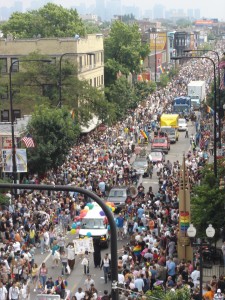NPS LGBT initiative: An opportunity for public historians
25 June 2014 – Laura Feller

Chicago Pride Parade, 2006. Photo credit: Adam Dixon, Wikimedia Commons
In late May, the National Park Service announced a theme study of sites associated with the histories of lesbian, gay, bisexual, and transgender individuals and communities. In a recent History@Work post, Sheila Brennan reported on the first public meeting of the advisory group for this initiative. I also attended this panel discussion and would like to encourage readers of History@Work to participate because your critical public history perspectives can contribute to the success of this project.
Although I no longer work for the National Park Service, I have been a staff NPS historian and, in the 1980s, worked on the National Historic Landmarks (NHL) program staff. In that time, the NPS embraced more heterogeneity in its telling of American history. This LGBT initiative continues the Park Service’s efforts to expand the scope of history at its sites and in the National Register of Historic Places and NHL programs. The initiative also offers public historians an important opportunity to contribute to a much-needed historical project.
In recent decades, NPS has become more open to exploring painful histories and historical ambiguities at sites such as Manzanar National Historic Site. Still, as discussants at the advisory meeting remarked, the desire to present inspiring stories of victories for individuals and for civil rights will necessarily be “in tension” with the necessity of telling painful stories about rights denied, homophobic violence, and identities suppressed. Public historians can play a critical role in making such tensions generative in that and other areas.
As a panelist at the advisory meeting remarked, “we are everywhere.” Public historians can contribute to the NPS study by helping address this question: How can we promote understanding of LGBT peoples’ experiences as central to American history and also serve the great variety of LGBT groups and their internal dynamics? LGBT individuals and communities will shape this study. Sharing stories among those communities will be a crucial goal, so that LGBT visitors to historic sites will see themselves and the stories of their communities at these sites in multiple ways. It is also crucial that this project encourage straight visitors to think afresh about LGBT experiences. Historical interpretation should foster empathy, encouraging visitors to try to understand the experiences of people who, for whatever reason, they may view as “other.” If we want to live together in civility, historic sites can help but only if visitors attempt the leap of imagination to see, empathetically, others’ experiences, not just their own.
This theme study will necessarily be guided by criteria for listing in the National Register of Historic Places. Secretary of the Interior Sally Jewell said at the panel discussion that “place matters.” As one panelist asked, “What does it mean to ‘place’ a history that has been placeless?” This project represents an opportunity for historians to explore that question and perhaps also to show how LGBT histories have not really been “placeless.” A related question is whether this LGBT initiative will also facilitate understanding of sites that do not meet criteria for listing on the National Register but nevertheless are places where important stories can and should be told. Similarly, mapping and otherwise connecting individual places to broader contexts could open interpretive possibilities that are difficult to engage at a single site.
This theme study presents important opportunities to investigate, demonstrate, and foreground “the power of place.” It is also an opportunity to talk about interpreting histories that are not only important to all of us but also intensely particular and “owned” by specific communities. It is potentially a place to showcase best practices in bringing together activists, community members, scholars, preservationists, teachers, and interpreters in the service of civil conversations about contested aspects of our shared past.
Public historians can help with this theme study in multiple ways, including voicing their understanding of historical contexts for the study, pointing to places that should be evaluated and stories that must be told, advising about best practices for facilitating dialogues about painful histories in such “official” settings, and involving scholars and activists as key figures in an inclusive process. Find out more and share your comments here.
~ Laura Feller is an independent historian living in Washington, DC



